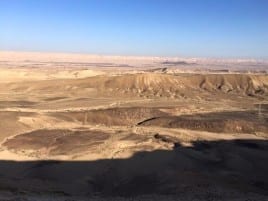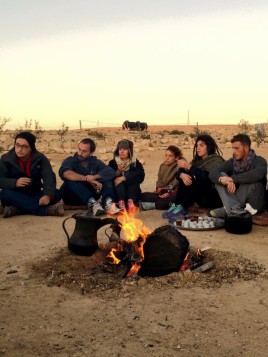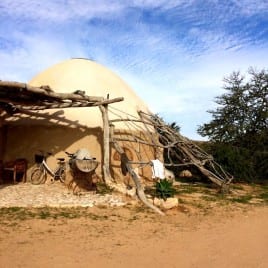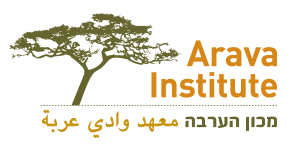
On Tuesday morning we woke up before the sun, and drove north towards Makhtesh Ramon. An hour and a half later, we found ourselves analyzing dozens of 65 million year old Ammonite fossils. Ammonites were aquatic mollusks, whose closest living relatives are squid, octopus and cuttlefish. We hiked up to the southern ridge of Makhtesh Ramon, the largest erosion crater in the world and learned about its unique geologic history. Then we drove to the town of Mitzpe Ramon, where we learned about the culture of this relatively small remote desert town, namely the Moroccan Jews, the National Religious community, the “Neo-bohemian” community and the Black Hebrew or Hebrew community. Every group has its own way of life, yet the amalgamation of each has created a culture unique to Mitzpe, proving that the whole of the culture of the town is greater than the sum of its parts. We ended our first day of the trip in the unrecognized Bedouin settlement of Wadi Aricha, just 15 minutes outside the city, where we ate traditional Bedouin food and sat by the fire and learned the incredible life story of our host, Salman Sadan, who is an important and well known activist for the rights of Bedouins in the area, in part due to his extreme kindness to everyone he meets, regardless of their religious or political affiliation.

We woke up the next morning and after many cups of Bedouin tea and coffee, headed north to Avedat, where we learned about the story of this single family farm. Stretching across route 40, from Be’er Sheva to Mitzpe Ramon, there are 23 relatively large farms owned by Jewish Israelis. The main uses are agriculture and/or tourism, and their status was only recently deemed legal by the State of Israel, as they were originally built on public land. Some have had clashes with neighboring Bedouin communities, some have had successful cooperation and coexist in peace. As an American, it was difficult for me to understand why these farms were so controversial, especially when they were only around 50 dunams (12 acres) in size. I have relatives in Eastern Colorado who have farms that are hundreds of acres! I did not realize how limited and therefore valuable space is in this country.
For lunch, we drove to Tel Sheva, one of seven Bedouin towns that were built by the State of Israel specifically for the Bedouin people. Tel Sheva was the first of these towns to be built in the 1960s, yet it is currently the poorest. We had lunch with Mariam Abo Rogaig, a Bedouin woman who established her own business by making cosmetics using traditional Bedouin ingredients in recipes passed down from her grandmother. Her trademark is Camel Milk Soap, of which she claims she is the first producer. Her story was the most inspiring to me, as she decided to get a college education in England instead of an arranged marriage, and went on to start her own business which is now flourishing in a community currently plagued by poverty.

We spent the night in one of the aforementioned single family farms. Our host, Rodney Hirsh, told us his story, and how he was able to cooperate and peacefully coexist with the Bedouin settlement only 1km from his house. His home is handmade entirely of mud, and so our environmentally conscious group was enthralled to see how you can build a house of natural and local materials.
On Thursday morning we visited a small Jewish settlement near Rodney’s farm Holot Makman, which boasts religious diversity – religious and secular Jewish Israelis living together. We then drove to Sde Boker, home of David Ben-Gurion, the first Prime Minister of Israel and promoter of blooming the Negev, and reflected upon the trip. The overall theme of the trip was Jews, Bedouins, and the environment. I was inclined to draw parallels with the United States and the relationship between the European Settlers, the Native Americans, and the resulting effects on the environment. Coincidentally (or not), it was also Thanksgiving in the US.
Thursday afternoon we took a Jeep tour to a the Ein Akev spring in the valley below Sde Boker. A few of us jumped in the extremely cold pool. I could only last about two minutes! That evening, we met with Alumni of the Institute and current Master’s and PhD students at Ben Gurion University of the Negev. After a delicious pizza dinner, we finally drove back to Ketura. A jam-packed trip for sure, but one that I will never forget.
Submitted by Jaclyn Best

